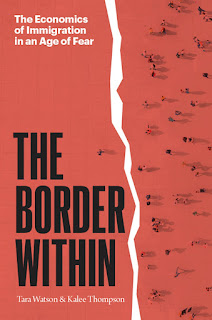 labor economics. Kalee Thompson is a journalist and senior editor at Wirecutter. She is the author of Deadliest Sea: The Untold Story Behind the Greatest Rescue in Coast Guard History.
labor economics. Kalee Thompson is a journalist and senior editor at Wirecutter. She is the author of Deadliest Sea: The Untold Story Behind the Greatest Rescue in Coast Guard History.
Watson and Thompson applied the “Page 99 Test” to their new book, The Border Within: The Economics of Immigration in an Age of Fear, and reported the following:
On page 99 of The Border Within: The Economics of Immigration in an Age of Fear, we’re discussing the 2015 shooting death of a young woman in San Francisco, Kathryn Steinle. The man who discharged the gun, Jose Ines Garcia Zarate, was an unauthorized Mexican immigrant who had been deported multiple times and was released from jail a few months before the killing. It was a prominent tragedy that took on outsized significance in the ongoing debates over undocumented immigration in the US.Learn more about The Border Within at the University of Chicago Press website.
From page 99 of The Border Within:Steinle’s death coincided with the early days of the primaries for the 2016 presidential election, and the tragedy quickly became a rallying cry for Republican candidates convinced that immigrants were driving up crime rates—or, more cynically, calculating that saying so would be a winning argument with certain voters. … Donald Trump, then considered a wild-card candidate, had announced his presidential bid on June 16, 2015. “When Mexico sends its people, they’re not sending their best,” he told the crowd at Trump Tower in New York City. “They’re sending people that have lots of problems, and they’re bringing those problems with us. They’re bringing drugs. They’re bringing crime. They’re rapists. And some, I assume, are good people.”Does our book pass the Page 99 Test? Arguably, yes. Most of The Border Within is focused on immigration and the American economy and the lives of everyday undocumented Americans, as opposed to extreme and high-profile events like the San Francisco pier shooting. Still, this passage “reveals the quality of the whole” by illustrating how politicized and polarizing the immigration issue has become, a theme that runs through the book.
In the weeks after Steinle’s killing, Trump repeatedly used her death as an argument in favor of his proposed border wall and mass deportations of undocumented Mexicans living in the United States. He didn’t change his tune when Zarate was acquitted by a jury in 2017, tweeting “The Kate Steinle killer came back and back over the weakly protected Obama border, always committing crimes and being violent, and yet this info was not used in court. His exoneration is a complete travesty of justice. BUILD THE WALL!”
As it turned out, the pistol used in Kathryn Steinle’s killing had been stolen from the vehicle of a Bureau of Land Management ranger a few days before the shooting. There was no evidence that Zarate had anything to do with that theft; instead, Zarate, who had seemingly been homeless since his release from San Francisco jail, spending his days collecting bottles and cans for recycling, randomly found the gun wrapped in a T-shirt under a bench on a San Francisco pier. Though his defense argued that the gun discharged accidentally without Zarate even unwrapping it, even if Zarate had intentionally pulled the trigger, he shot at random; ballistic evidence determined that the gun was discharged from close to the ground; the bullet ricocheted off the concrete pier, traveling another seventy-eight feet before hitting Steinle. The jury found no evidence that Zarate, who had no history of violence in his criminal record, had any intent to kill anyone.…
The account on page 99 opens a discussion of so-called “sanctuary cities” and the inconsistent enforcement of immigration law across cities and states. We devote many pages later in the book to immigration and crime—and the well-established fact that, contrary to popular belief, immigrants do not have an adverse impact on crime rates. But right here, we’re more focused on rhetoric and politics. In the months that followed the shooting, dozens of state and federal bills were introduced aimed at punishing so-called sanctuary cities that shield immigrants from federal authorities. The deeply tragic yet arbitrary death of a beautiful young white woman ended up being a powerful, if somewhat misleading, bit of storytelling for those in favor of harsher enforcement of immigration laws.
--Marshal Zeringue



